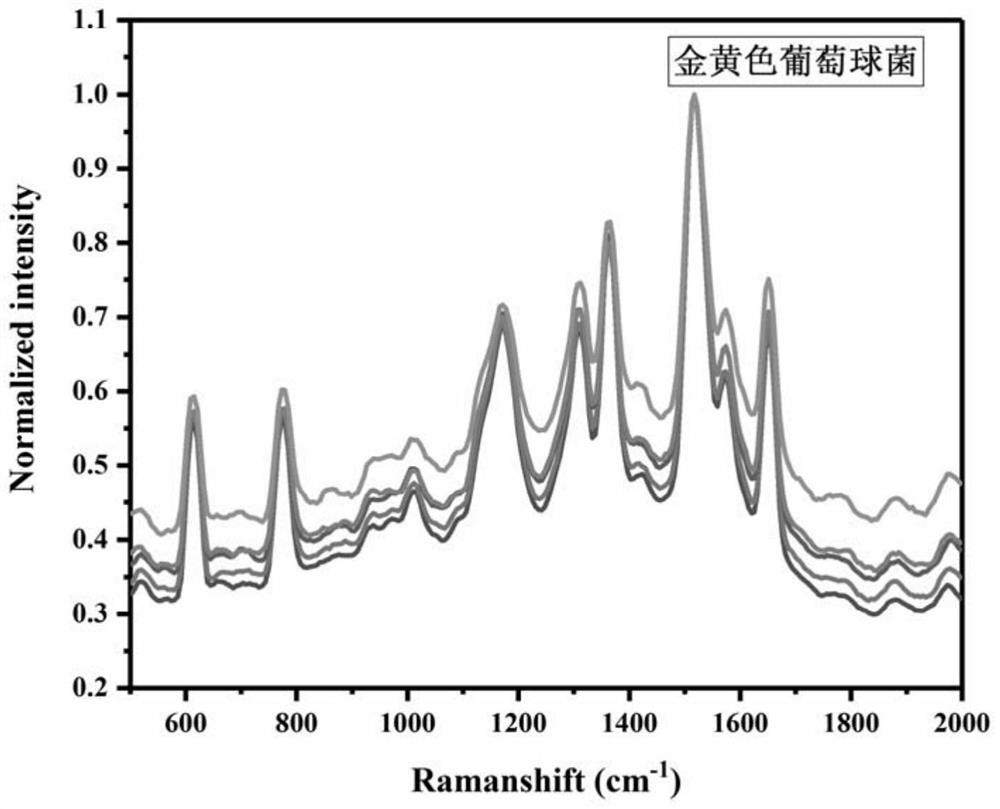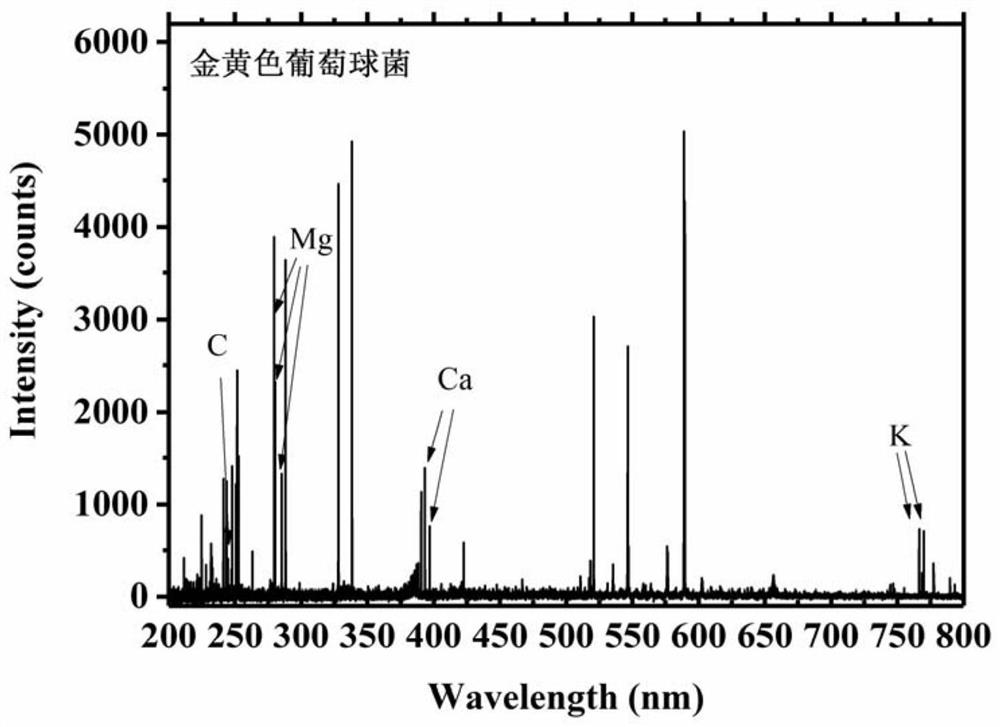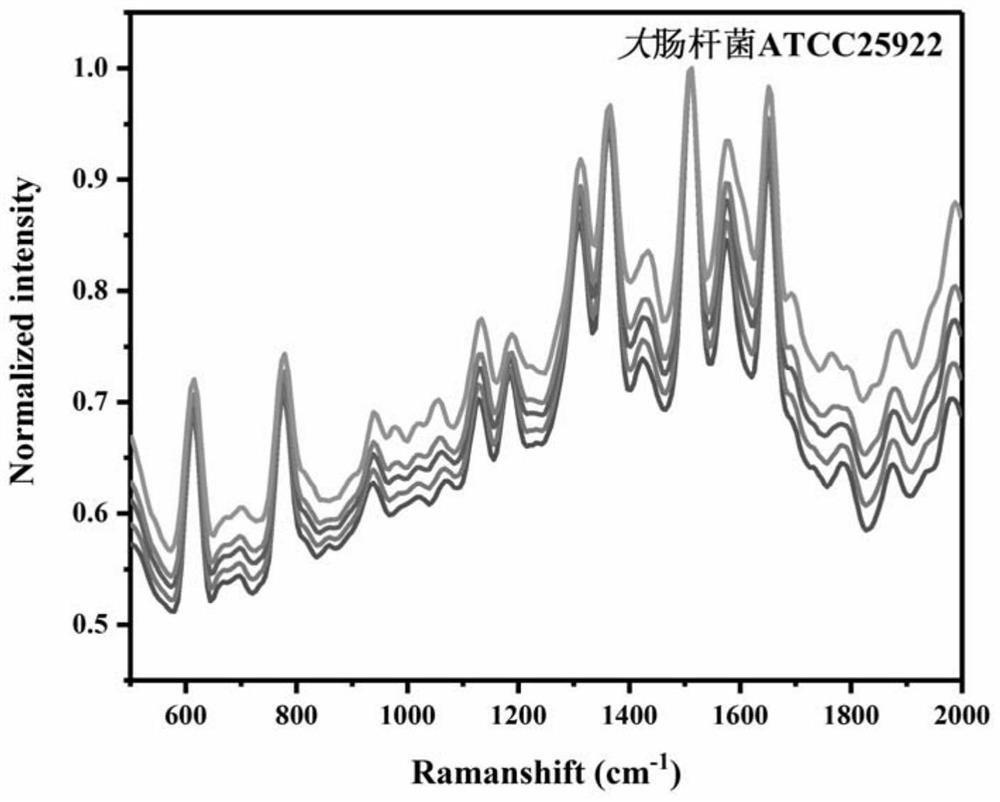A rapid detection method for bacteria based on surface-enhanced Raman scattering-laser-induced breakdown spectroscopy
A technology of bacteria and spectroscopy, applied in Raman scattering, measuring devices, thermal excitation analysis, etc., can solve the problems of poor reproducibility and stability, great difficulty, and the inability to ensure uniform distribution of nanoparticles, etc., to achieve good accuracy , the effect of simple operation
- Summary
- Abstract
- Description
- Claims
- Application Information
AI Technical Summary
Problems solved by technology
Method used
Image
Examples
Embodiment 1
[0040] Embodiment 1 Detection method of the present invention
[0041] Parameters of the LIBS-Raman combined device: the continuous laser used to excite Raman scattering is a semiconductor-pumped all-solid-state laser with an output wavelength of 532nm and a power of 50-400mW. The pulsed laser used for LIBS is a Q-switched Nd:YAG laser with an output wavelength of 1064nm, a pulse repetition frequency of 1-20Hz, and a single pulse with a maximum energy of 100mJ.
[0042] When performing Raman testing, the laser power is attenuated to 15mW through the attenuation sheet, the objective lens is 10 times larger, the slit of the spectrometer is 25um, and the Raman scanning range is 500-2000cm -1 , the resolution is about 4-7cm -1 ; When performing LIBS experiments, the pulse energy of the pulsed laser is 30mJ, and the repetition frequency of the pulsed laser is 10Hz.
[0043]1) Bacterial culture: Inoculate the known strains in 25 mL of trypticase soy broth (TSB), shake and culture ...
Embodiment 2
[0047] Embodiment 2 The present invention qualitatively detects bacteria
[0048] 1) Bacterial culture: inoculate unknown strains in 25 mL of tryptone soy broth (TSB), shake and culture at 37°C for 10 hours, take 5 mL of cultured bacterial liquid, centrifuge at 6000 rpm for 5 min, and wash with ultrapure water Three times, finally dispersed in ultrapure water, measure OD 600 And determine the bacterial concentration by plate count.
[0049] 2) Hydrophobic substrate preparation: In the present invention, a silicon wafer is used as a substrate-loaded sample for SERS and LIBS detection. In order to prevent the signal strength from weakening due to sample diffusion, the silicon wafer needs to be hydrophobized in advance, that is, the silicon wafer is ultrasonicated in acetone and water ( 40KHz) for 10 minutes, then soak in concentrated H 2 SO 4 (98%) and H 2 o 2 (30%) in a mixed solution with a volume ratio of 3:1 and heated at 90°C for 30 minutes, washed with deionized water...
Embodiment 3
[0052] Embodiment 3 The present invention quantitatively detects bacteria
[0053] (1) Take a known bacterial solution with a certain volume concentration and disperse it in ultrapure water to make a concentration of 5×10~5×10 7 CFU / mL bacterial solution, as a standard;
[0054] (2) Take a 0.8cm*0.8cm silicon wafer, wash it ultrasonically with acetone and water for 10 minutes, and then soak it in concentrated H 2 SO 4 (98%) and H 2 o 2 (30%) in a mixed solution with a volume ratio of 3:1 and heated at 90°C for 30 minutes, washed with deionized water, soaked in 5% HF solution for 30 minutes to form Si-H bonds on the surface, and finally nitrogen Blow dry to get hydrophobic silicon wafer.
[0055] (3) Bacterial in situ synthesis of AgNPs: Take 1mL of the standard product in a 1.5mL centrifuge tube, add 10μL of 0.1mol / L silver nitrate, vortex and mix for 10 minutes, then add 10μL of 0.2mol / L sodium borohydride, turn over and centrifuge Tubes generate AgNPs in situ in the ba...
PUM
| Property | Measurement | Unit |
|---|---|---|
| electrical resistivity | aaaaa | aaaaa |
Abstract
Description
Claims
Application Information
 Login to View More
Login to View More - R&D
- Intellectual Property
- Life Sciences
- Materials
- Tech Scout
- Unparalleled Data Quality
- Higher Quality Content
- 60% Fewer Hallucinations
Browse by: Latest US Patents, China's latest patents, Technical Efficacy Thesaurus, Application Domain, Technology Topic, Popular Technical Reports.
© 2025 PatSnap. All rights reserved.Legal|Privacy policy|Modern Slavery Act Transparency Statement|Sitemap|About US| Contact US: help@patsnap.com



